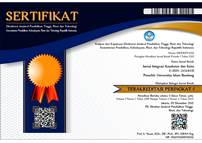Faktor Risiko Nyeri Punggung Bawah pada Ibu Rumah Tangga
Abstract
Nyeri punggung bawah (NPB) menjadi penyebab utama kecatatan di hampir semua negara. NPB merupakan nyeri yang terlokalisasi di bawah costal margin dan di atas gluteal fold. Masih sangat sedikit penelitian mengenai ibu rumah tangga yang mengalami nyeri punggung bawah. Tujuan penelitian ini mengetahui faktor risiko yang dapat menyebabkan NPB pada ibu RT. Penelitian ini menggunakan metode deskriptif observasional dengan desain cross sectional. Subjek diambil dengan consective sampling berdasar atas kedatangan pasien. Data didapat dari pasien yang datang pada periode Juni–Juli 2019 di RSUD Al-Ihsan Bandung sebanyak 40 subjek. Pengolahan data dilakukan menggunakan program SPSS versi 24. Hasil penelitian menunjukkan 40 orang subjek NPB dengan faktor risiko usia 30–50 tahun (73%), pendidikan SMA (35%), IMT dalam kategori normoweight (50%), posisi bekerja berdiri (82,5%), riwayat pernah bekerja (52,4%), lama kerja 5–10 tahun (20%), dan pasien yang melakukan terapi (62.5%). Simpulan penelitian ini risiko yang paling memengaruhi terjadi nyeri punggung bawah pada ibu rumah tangga adalah faktor usia, pendidikan SMA, IMT normoweight, posisi bekerja berdiri, dengan riwayat pernah melakukan pekerjaan.
RISK FACTORS OF LOW BACK PAIN IN HOUSEWIFE
Lower back pain (LBP) is the main cause of disability in almost all countries. LBP is pain localized below the costal margin and above the gluteal fold. There is still very little research on housewives who experience low back pain. The purpose of this study was to determine the risk factors that could cause NPB in Housewifes. This study used an observational descriptive method with cross sectional design. Subjects taken by consective sampling based on the arrival of patients. Data obtained from patients who came in the period June–July 2019 at Al-Ihsan Regional Hospital Bandung as many as 40 subjects. Data processing was carried out using SPSS version 24. The results showed 40 LBP subjects with risk factors age 30–50 years (73%), high school education (35%), BMI in the normoweight category (50%), work position standing (standing 82.5%), history of having worked (52.4%), working time 5–10 years (20%), and patients undergoing therapy (62.5%). The conclusion of this study the risks that most influence the occurrence of low back pain in housewives are age, high school education, BMI normoweight, standing work position, with a history of ever doing work.
Keywords
Full Text:
PDFReferences
GHDX. Global burden of disease collaborative network. socio-demographic index,. 2017. [diunduh 19 September 2019]. Tersedia dari: http://ghdx.healthdata.org/record/ihme-data/gbd-2017-socio-demographic-index-sdi-1950%E2%80%932017
WHO. Low back pain. 2010. [diunduh 23 September 2019]. Tersedia dari: https://books.google.co.id/books?id=avnwCwAAQBAJ&pg=PA959-IA1&lpg=PA959-IA1&dq=WHO.+Low+back+pain.+2010:24;+8%E2%80%9310&source=bl&ots=xaIdp1txMt&sig=ACfU3U0Pwh0y83qxwJm1nQQ9KtTuqyegsA&hl=en&sa=X&ved=2ahUKEwip4MHX4fnpAhWXeX0KHT0eCE0Q6AEwCnoECAoQAQ#v=onepage&q=WHO.%20Low%20back%20pain.%202010%3A24%3B%208%E2%80%9310&f=false
Sonia A. Prevalence of low back pain among the housewives. 2014. [diunduh 2 Oktober 2019]. Tersedia dari: http://202.4.109.28:8080/xmlui/handle/123456789/118
Braunwald E. Heart failure and cor pulmonale. Dalam: Kasper DL, Braunwald E,Fauci AS, Hauser SL, Longo DL, Jameson JL, penyunting. Harrison’s principle of internal medicine. Edisi ke-16. New York: McGraw Hill; 2005. hlm. 94–103.
Wáng YXJ, Wáng J, Káplár Z. Increased low back pain prevalence in females than in males after menopause age: evidences based on synthetic literature review. Quant Imaging Med Surg. 2016;6(2):199–206.
Health and Safety Authority. Ergonomics in the Workplace. 2006. [diunduh 6 September 2019]. Tersedia dari: https://www.hsa.ie/eng/Publications_and_Forms/Publications/Manual_Handling_and_Musculoskeletal_Disorders/Ergonomics_in_the_Workplace.html
Program A. Workplace Ergonomics Reference Guide 2 A Publication of the Computer / Electronic Accommodations Program Real Solutions for Real Needs Table of Contents. 2010. [diunduh 19 September 2019]. Tersedia dari: http://www.cap.mil/Documents/CAP_Ergo_Guide.pdf
Pope MH, Goh KL, Magnusson ML. Spine Ergonomics. 2002;(4):49–68.
Purnamasari H, Gunarso U, Rujito L. Overweight sebagai faktor resiko low back pain pada pasien poli saraf RSUD prof. Dr. Margono Soekarjo Purwokerto. Mandala Health. 2010 Jan;4(1):26–31.
Koesyanto H. Masa kerja dan sikap kerja duduk terhadap nyeri punggung. KEMAS. 2013;9(1):9–14.
Andini F. Risk factors of low back pain, workers. J Mayority. 2015;4(1):12–9.
Junaidi H. Ibu rumah tangga: streotype perempuan pengangguran. An Nisa’a: J Kajian Gender Anak. 2017;(12):76–8.
Alfons OL, Goni SYVI, Pongoh H. Peran ibu rumah tangga dalam meningkatkan status sosial keluarga. Acta Diurna Komunikasi. 2017;6(2):1–11.
Goel S, Mani P, Divya M. Low back ache in working women of reproductive age group. New Indian J Obgyn. 2018;5(1):43–6.
Gupta G, Tiwari D. Prevalence of low back pain: Non-working women in Kanpur City, India. J Musculoskelet Pain. 2014;22:133–8.
Santiasih I. Kajian manual material handling terhadap kejadian low back pain pada pekerja tekstil. J Teknik Industri. 2013;8(1):21–6.
Edomwonyi EO, Ogbue IA. Epidemiology of low back pain in a Suburban Nigerian Tertiary Centre. NJSS. 2017;27(1):20–5.
Novitasari DD, Sadeli HA, Soenggono A, Sofiatin Y, Sukandar H, Roesli RMA. Prevalence and characteristics of low back pain among productive age population in Jatinangor. Althea Med J. 2016; 3(3):469–76.
Astuti I, Septriana D, Romadhona N, Achmad S, Kusmiati M. Nyeri punggung bawah serta kebiasaan merokok, indeks massa tubuh, masa kerja, dan beban kerja pada pengumpul sampah. JIKS. 2019;1(1):74–8.
Patrianingrum M, Oktaliansah E, Surahman E. Prevalensi dan faktor risiko nyeri punggung bawah di lingkungan kerja anestesiologi Rumah Sakit Dr. Hasan Sadikin Bandung. JAP. 2015;3(1): 47–56.
Shieh S, Sung F, Su C, Tsai Y, Hsieh VC. Increased low back pain risk in nurses with high workload for patient care: a questionnaire survey. Taiwan J Obstet Gynecol. 2019;55(4):525–9.
Weerasekara I, Hiller CE. Chronic musculoskeletal ankle disorders in Sri Lanka. BMC Musculoskelet Disord. 2017;18:1–8.
Anggraini MT, Jenie MN, Ronica DW. Durasi kerja meningkatkan kejadian low back pain pada buruh pabrik rokok. J Kedokteran Muhammadiyah. 2014;3(2):1–4.
Dhone S, Khare T. Evaluation of musculoskeletal disorders among the house wives in Nagpur City, Maharashtra. IJRISS. 2017;1(1):39–40.
DOI: https://doi.org/10.29313/jiks.v2i1.5603
Refbacks
- There are currently no refbacks.
Jurnal Integrasi Kesehatan dan Sains is licensed under a Creative Commons Attribution-NonCommercial-ShareAlike 4.0 International License.







.png)
_(1).png)




















